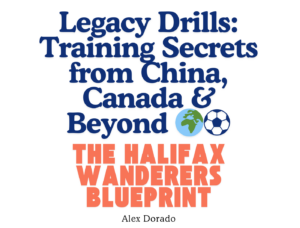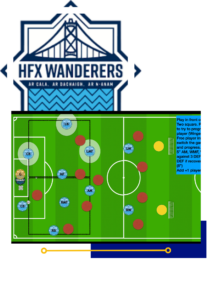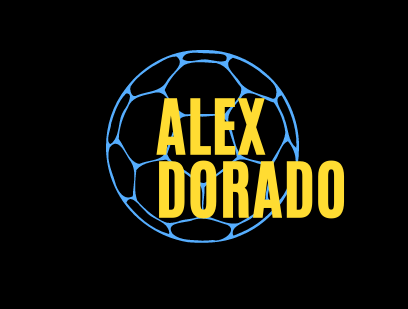
Football with Purpose: Playing to Play, Not to Repeat
Today, we’re not going to talk about a specific drill—we’re going to talk about the idea behind Halifax Wanderers’ build-up play and how that idea gave rise to training exercises.
A core idea, developed after analyzing the players and other elements we’ve discussed in previous articles, can lead us to create exercises to implement it—not the other way around.
Personalizing what we do with our team—in this case, Halifax Wanderers and its players—is key.
Context
We’re in the 2022 season with Halifax Wanderers in Canada. Pre-season was held during the winter, in a region where snow, cold, and wind made outdoor training impractical. Because of this, we trained indoors, with all the advantages that setting provided: pleasant temperature, no wind interruptions, quality artificial turf, internet access, and use of a TV… Conditions that might be limiting in some ways, but ideal when it comes to preseason learning and absorbing new concepts.
We frequently used the TV during training breaks to show players the ideas and concepts we wanted to work on.
As mentioned earlier, analyzing the specific characteristics of each player—as well as the context and competition—is key to deciding what to implement. In this case, that meant our build-up strategy, which I’ll now focus on.
The first priority was understanding our team’s strengths: which players would likely start, what were their qualities, and what limitations did we face?
Having a striker who can beat defenders in aerial duels is completely different from having one who excels at receiving between the lines or making runs in behind.
In our case, we had a player who could make a real difference in the league, and he helped shape our final idea.
Many of you reading this will know what happened that year—João Morelli suffered a serious injury after just the second league match, which disrupted what we had planned based on his presence. But this is where evolution comes in—adapting the idea over time, finding new options, and responding to the setbacks we encountered.
Starting with João Morelli—a player with the technical quality of an attacking midfielder, able to link up, carry the ball, and play the final pass, and the finishing of a striker—we were able to play with multiple possibilities. His flexibility allowed us to adapt based on the rest of the squad’s characteristics.
Since his position could shift between striker and attacking midfielder, the next step in the analysis was our central midfield options.
There we had one of our captains and team leaders—Trinidad and Tobago international Andre Rampersad. A positional midfielder with size, the ability to combine, and especially to provide defensive cover at any moment in the game. One of his limitations was his low finishing rate, despite his strong intent to try. This led us to play Rampersad as a defensive midfielder, supported by two more advanced midfielders.
By doing this, we limited the number of runs into the opposition box but gained a smart positional player who helped during transitions and also during the build-up.
That brings us to the previous decision. With Rampersad as our sole holding midfielder, Morelli had two options: play as a midfielder (moving him away from the box), or as a center forward. We chose the latter, to keep him close to goal. Playing with four midfielders in a diamond would have required a back three, which would have disrupted our wide players—who made up the majority of our squad.
Players like Fernandez, Tabi, Ruby, Gander, Salter, Marshall, and Bent all had profiles suited to fullback or winger roles. Some, like Samuel Salter, could have fit elsewhere, but we placed him out wide based on his traits.
Every player needs a specific space and time to perform, and our prior analysis of Salter told us: the smaller the space and time, the lower the performance. His natural movements aligned with those of a winger—and that’s where he delivered the best goal-scoring numbers of his career so far.
In central defense and midfield, we had players like Lapare, Lamothe, Daniels, Polisi, Mo, Santos, Schaale, Restrepo, and Son—all capable of combining and playing through pressure. In goal, both Oxner and Baskett gave us strong guarantees.
From this came our team structure: a 4-3-3 with Morelli as a false 9 and our wingers playing more interior roles—positioned between the opponent’s fullback and center-back—creating a shape that often looked like a 4-4-2 diamond.

Build-up Play
The idea was to create numerical superiority on one flank to either switch play or find a pass behind the opposing midfield line.
To achieve this, we pinned the opposition’s back four with our two wingers positioned between the fullbacks and center-backs—causing doubt for both. These two became our long-ball targets—either running in behind (like Bent, Marshall) or contesting aerial balls (like Salter).
Morelli was given freedom to be the player who created overloads within an imaginary square on either flank—formed by the fullback, center-back, holding midfielder, and one central midfielder. This became a kind of rondo: four on the outside, one inside.
Our opposite-side central midfielder had an important role—providing an inside passing option behind the opposing midfield line, in case they stepped up to press.
If the opposing team marked that “imaginary square” with more players, creating an even situation, we’d switch play through our goalkeeper to the other side—where our fullback, center-back, and central midfielder would be free.
From this main idea, secondary concepts and specific training drills began to emerge.
In the next article, I’ll break down the build-up system used at Black Leopards—a structure that shares similarities with Halifax but also has key differences.
A personalized build-up—where the idea continues.
🚀 Want more content like this? Real tactics, personalized strategies, and ideas that actually make sense on the pitch!
📲 Follow us on Instagram @alexdorateam for behind-the-scenes insights, exclusive tips, and conversations that go beyond the obvious.
📚 Hungry to keep learning? Check out more articles like this and dive into football with purpose! ⚽🔥
